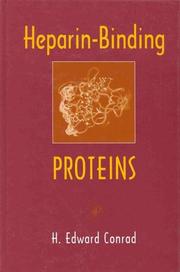| Listing 1 - 10 of 124 | << page >> |
Sort by
|
Book
Year: 2012 Publisher: Bruxelles: UCL. Faculté de pharmacie et des sciences biomédicales,
Abstract | Keywords | Export | Availability | Bookmark
 Loading...
Loading...Choose an application
- Reference Manager
- EndNote
- RefWorks (Direct export to RefWorks)
Book
Year: 2012 Publisher: Bruxelles: UCL,
Abstract | Keywords | Export | Availability | Bookmark
 Loading...
Loading...Choose an application
- Reference Manager
- EndNote
- RefWorks (Direct export to RefWorks)
Adiponectin --- Anti-Inflammatory Agents --- lipopolysaccharide-binding protein

ISBN: 1402014341 Year: 2003 Publisher: Dordrecht : Kluwer academic,
Abstract | Keywords | Export | Availability | Bookmark
 Loading...
Loading...Choose an application
- Reference Manager
- EndNote
- RefWorks (Direct export to RefWorks)
Book
Year: 2020 Publisher: Frontiers Media SA
Abstract | Keywords | Export | Availability | Bookmark
 Loading...
Loading...Choose an application
- Reference Manager
- EndNote
- RefWorks (Direct export to RefWorks)
This eBook is a collection of articles from a Frontiers Research Topic. Frontiers Research Topics are very popular trademarks of the Frontiers Journals Series: they are collections of at least ten articles, all centered on a particular subject. With their unique mix of varied contributions from Original Research to Review Articles, Frontiers Research Topics unify the most influential researchers, the latest key findings and historical advances in a hot research area! Find out more on how to host your own Frontiers Research Topic or contribute to one as an author by contacting the Frontiers Editorial Office: frontiersin.org/about/contact
glycans --- carbohydrates --- glycoimmunology --- glycan binding protein (GBP) --- chemical biology
Dissertation
ISBN: 9052784078 Year: 2004 Publisher: Maastricht Universitaire Pers Maastricht
Abstract | Keywords | Export | Availability | Bookmark
 Loading...
Loading...Choose an application
- Reference Manager
- EndNote
- RefWorks (Direct export to RefWorks)
Signal Transduction --- Viral Proteins --- GTP-Binding Protein alpha Subunits, Gi-Go --- Receptors, Cell Surface --- GTP-Binding Protein beta Subunits --- Cytomegalovirus --- DNA, Viral --- genetics --- metabolism --- chemistry

ISBN: 1281118915 9786611118914 0080533906 0121860604 9780121860608 9780080533902 9781281118912 Year: 1998 Publisher: San Diego : Academic Press,
Abstract | Keywords | Export | Availability | Bookmark
 Loading...
Loading...Choose an application
- Reference Manager
- EndNote
- RefWorks (Direct export to RefWorks)
This book describes the complex structures of heparins and heparan sulfates (heparinoids) and how they are generated by their biosynthetic pathways. The book also details the methodologies for studying these structures and their cellular metabolism. Heparin-Binding Proteins introduces the general nature of interactions between heparinoids and proteins, and presents the role for these structures in their interactions with the proteins of the hemostatic mechanisms, fibroblasts growth factors, superoxide dismutase, and lipoproteins.Key Features* Covers cellular metabolism of he
Proteoglycans. --- Protein binding. --- Heparin. --- Anticoagulants (Medicine) --- Polysaccharides --- Binding, Protein --- Biochemistry --- Allosteric proteins --- Radioligand assay --- Glycoproteins
Book
Year: 2009 Publisher: Bruxelles: UCL,
Abstract | Keywords | Export | Availability | Bookmark
 Loading...
Loading...Choose an application
- Reference Manager
- EndNote
- RefWorks (Direct export to RefWorks)
The systemic Inflammatory Response Syndrome (SIRS) occurs in response to an injury to stimulate the host defences in a coordinated fashion. This syndrome is mediated by the activation of endocrine and cytokines networks, may lead to muscle proteolysis and atrophy. Although the mechanisms involved in SIRS-induced muscle atrophy are not well established, the decrease in muscular expression of the insulin-like growth factor I (IGF-I), an anabolic growth factor for muscle, observed in SIRS suggests that IGF-I might play a role. Therefore, the goal of our present work was to investigate whether the reduction of IGF-I muscle levels is responsible for the activation of the genes involved in SIRS-induced muscle atrophy.
First, we characterized the SIRS-induced muscle atrophy model in rats. LPS injection was used to study the first stages of the common inflammatory response syndrome that leads to muscle catabolism in sepsis. In our model, the atrophy is characterized by a diminution of the myofibrillar proteins levels, explained by the activation of the ubiquitin-proteasome and the lysosomial systems, as illustrated by the increased mRNAs of several genes of these two proteolytic systems. Furthermore, our work showed that the induction of these genes is probably mediated by the activation of the transcription factor Foxo3a, which is normally inhibited by IGF-I.
Secondly, we investigated whether the muscle overexpression of IGF-I prevents the induction of the genes involved in SIRS-induced muscle atrophy. To respond to this question, we used transgenic mice which overexpress IGF-I specifically in skeletal muscle (mTr-IGF-I mice). According to our hypothesis, the overexpression of IGF-I in these mice should prevent the activation of the genes involved on SIRS-induced muscle atrophy. Surprisingly, our work showed that the LPS injection activates the genes involved in SIRS-induced muscle atrophy without reduction of the muscle expression of IGF-I. Furthermore, our results indicated that the muscle overexpression of IGF-I doesn’t prevent the induction of the genes of proteolytic systems involved in SIRS-induced muscle atrophy. The absence of prevention of the activation of the genes involved in SIRS-induced muscle atrophy could probably be explained by the absence of reduction of Foxo3a in the mTr-IGF-I mice after LPS injection.
To conclude, the overexpression of IGF-I doesn’t prevent the activation of the genes involved in SIRS-induced muscle atrophy. This work indicates therefore that mediators other than IGF-I, in particular TNFα (by the transcription factor NFκB) or glucocorticoids, might be involved in the activation of the SIRS-induced muscle atrophy Le syndrome de réaction inflammatoire systémique (SIRS) est déclenché en réponse à une agression. Son but est de stimuler de façon coordonnée les mécanismes de défense de l’organisme. Il est médié par l’activation de cytokines et du système endocrinien. Le SIRS s’accompagne d’une protéolyse accélérée de la masse musculaire menant à l’atrophie. Bien que les mécanismes responsables de l’atrophie musculaire induite par le SIRS soient encore mal connus, cette atrophie s’accompagne d’une diminution de l’expression musculaire du facteur de croissance IGF-I. ainsi, nous avons formulé l’hypothèse que l’activation du programme génique menant à l’atrophie musculaire au cours du SIRS pourrait résulter de la diminution de l’IGF-I musculaire.
Dans une première étape, nous avons caractérisé le modèle d’atrophie musculaire associé au SIRS chez le rat. L’injection de LPS ou endotoxine a été utilisée pour déclencher un SIRS aigu. Cette atrophie musculaire se caractérise par une diminution de la quantité des protéines myofibriallaires, secondaire à l’activation du système ubitiquine-protéasome et du système lysosomial. Nos données montrent que l’induction de ces deux systèmes protéalytiques est probablement médiée par l’activation du facteur de transcription Foxo3a. Dans une seconde étape, nous avons tenté de déterminer si la surexposition musculaire de l’IGF-I prévient l’induction du programme génique d’atrophie musculaire ou cours du SIRS aigu. En pratique, nous avons cherché à savoir si les souris mTr-IGF-I sont protégées de l’induction du programme génique d’atrophie musculaire qui accompagne le SIRS. De façon surprenante, nos données montrent que le SIRS aigu induit le programme génique d’atrophie musculaire chez la souris en absence de toute réduction de l’expression musculaire de l’IGF-I. De plus, nos résultats indiquent que le surexpression musculaire de l’IGF-I ne prévient pas l’induction des gènes du SUP et du système lysosomial. L’échec de l’IGF-I à prévenir l’induction du programme génique d’atrophie est probablement secondaire à la persistance de l’induction de Foxo3a chez les souris mTr-IGF-I en réponse au LPS.
En conclusion, la surexpression musculaire du facteur de croissance IGF-I ne prévient pas l’induction du programme génique d’atrophie musculaire induite par le SIRS aigu. Ce travail suggère dès lors que d’autres médiateurs de l’atrophie musculaire induite par le SIRS aigu, comme par exemple le TNFα (via le facteur de transcription NFκB) ou les glucocorticoïdes, jouent probablement un rôle dans l’activation de l’atrophie musculaire par le SIRS aigu
Book
Year: 2020 Publisher: Frontiers Media SA
Abstract | Keywords | Export | Availability | Bookmark
 Loading...
Loading...Choose an application
- Reference Manager
- EndNote
- RefWorks (Direct export to RefWorks)
This eBook is a collection of articles from a Frontiers Research Topic. Frontiers Research Topics are very popular trademarks of the Frontiers Journals Series: they are collections of at least ten articles, all centered on a particular subject. With their unique mix of varied contributions from Original Research to Review Articles, Frontiers Research Topics unify the most influential researchers, the latest key findings and historical advances in a hot research area! Find out more on how to host your own Frontiers Research Topic or contribute to one as an author by contacting the Frontiers Editorial Office: frontiersin.org/about/contact
Science: general issues --- glycans --- carbohydrates --- glycoimmunology --- glycan binding protein (GBP) --- chemical biology
Dissertation
ISBN: 9162869515 9789162869519 Year: 2006 Publisher: Göteborg : Göteborg University,
Abstract | Keywords | Export | Availability | Bookmark
 Loading...
Loading...Choose an application
- Reference Manager
- EndNote
- RefWorks (Direct export to RefWorks)
Book
Abstract | Keywords | Export | Availability | Bookmark
 Loading...
Loading...Choose an application
- Reference Manager
- EndNote
- RefWorks (Direct export to RefWorks)
This eBook is a collection of articles from a Frontiers Research Topic. Frontiers Research Topics are very popular trademarks of the Frontiers Journals Series: they are collections of at least ten articles, all centered on a particular subject. With their unique mix of varied contributions from Original Research to Review Articles, Frontiers Research Topics unify the most influential researchers, the latest key findings and historical advances in a hot research area! Find out more on how to host your own Frontiers Research Topic or contribute to one as an author by contacting the Frontiers Editorial Office: frontiersin.org/about/contact
RNA regulatory enzyme --- RNA-binding protein --- RNA modification --- transcription --- translation --- tRNA --- quality control --- RNA processing
| Listing 1 - 10 of 124 | << page >> |
Sort by
|

 Search
Search Feedback
Feedback About UniCat
About UniCat  Help
Help News
News